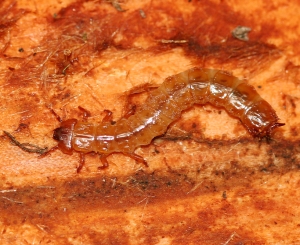This post is part of a series on the insect cuticle as a biological material that can inspire novel engineered materials. The characteristics of the cuticle, setting it apart from most synthetic/engineered materials, will be discussed in this series. The introduction to the series can be found here.
In Nature Easy Does It
Most biological materials, including the insect cuticle, are produced at ambient temperature and pressure. In addition, biological material synthesis often occurs in an aqueous environment. This is very different from how engineered materials are fabricated. Engineered materials are too commonly fabricated with the heat, beat and treat method.
A lot of energy is added to the process of fabricating engineered materials. The material is usually forced to conform by adding pressure to it from the top down, and then (not always benign) chemicals are added to give the material additional properties. Nature teaches us that fabrication under mild synthesis conditions is possible too.
In general, most physiological processes related to growth in insects, including the fabrication of new cuticle, occur at temperatures between 40-100°F (5-40°C) and at standard atmosphere (~760 mmHg). This fabrication occurs from the ground up, no big machinery is needed, and only benign chemicals are used.
In my bioinspiration courses I ask students to create an Ashby plot (comparing tensile strength vs Young’s modulus) for engineered and biological materials.
The activity reinforces that, at least for these two variables, biological materials are often as good, if not better, as engineered materials. Yet biological materials are fabricated at far milder synthesis conditions than engineered materials.
Some notes on how “extremophile insects” are able to survive, and maybe even grow, in extreme conditions.
Insects live in just about every habitat on Earth, from hot deserts and thermal springs to cold caves and frigid mountain streams. Clearly insects and other arthropods can survive some of the most inhospitable conditions on Earth. But some of extremophiles listed below will not molt under these extreme conditions.
- Desert ants such as Cataglyphis bicolor, which live in extremely hot deserts (Sahara), use behavioral tactics to function at midday temperatures. The stages that will have to produce new cuticle in order to grow, the larval stages, are present underground where temperatures are not as extreme.
- The flat bark beetle (Cucujus clavipes) larvae and adults survive arctic northern Alaskan winters by way of some clever blood chemistry that results in anti-freeze properties and prevents inter- and intra-cellular fluids from freezing. The larvae do not molt until the warmer periods and will do so under bark.
- The largest purely terrestrial animal on Antarctica is the tiny midge Belgica antarctica. This insect can survive extreme freezing temperatures, and dry habitat, by using its immediate environment as a barrier and through the management of body water as temperatures drop and come back up. Most of the larval growth however, including molting, only occurs during the warmest weeks when temperatures are well above freezing.
- Other extreme conditions that some arthropods deal with are lower pressures or very acidic water. The Himalayan jumping spider (Euophrys omnisuperstes) is able to survive at 20,000 feet (6000 meters) despite the lower air pressures (video). But the range of pressures that are encountered on Earth are not as great as the pressure difference humans create during manufacturing of engineered materials, when materials are often pounded into the desired shape.
- In one of the most inhospitable places on earth, Cueva de Villa Luz, a cave located in the southern Mexican state of Tabasco, arthropods thrive despite the fact that the waters have an extremely high concentration of hydrogen sulfide. Insects such as predatory belostomatid bugs, have been shown to live within these caves during all life stages. How physiological mechanisms, such as molting, are possibly altered in these acidic waters has not yet been studied in detail.









I get the gist of what you are saying however much of it is way over my head considering I have no training in the subject. You may check my level of expertise in my blog about ants and co-operation at thoughtsbyqt.word>Press.com. To support my quest for knowledge I will read more of your presentations. Thanks
Pingback: Insects have advanced degrees in Material Science and Manufacturing |